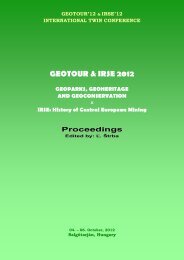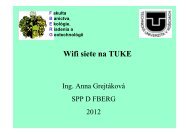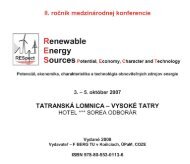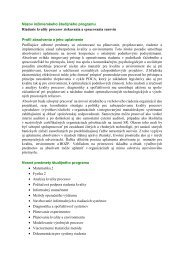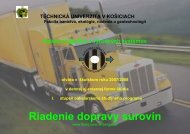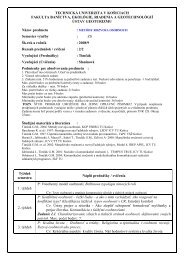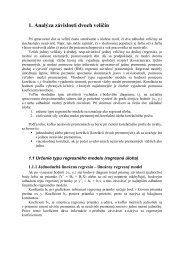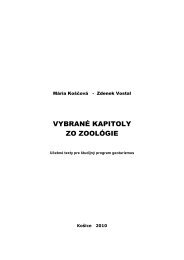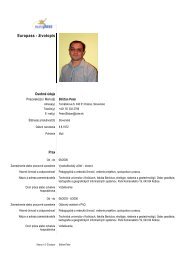GEOTOUR & IRSE 2012.pdf - Fakulta BERG - TUKE
GEOTOUR & IRSE 2012.pdf - Fakulta BERG - TUKE
GEOTOUR & IRSE 2012.pdf - Fakulta BERG - TUKE
Create successful ePaper yourself
Turn your PDF publications into a flip-book with our unique Google optimized e-Paper software.
<strong>GEOTOUR</strong> & <strong>IRSE</strong> 2012<br />
considerably earlier moment of their beginning, the sign of which can be the shape and size of<br />
the cross-section of the workings reopened during the mining and archaeological work<br />
conducted by the Mining Institute of the Wrocław University of Technology with the support<br />
of Wrocław Section of Speleologists. The first mine operating in the described region was<br />
Segen Gottes, which was relatively large for the Sowie Mountains‟ conditions. As known<br />
from the survived documents, while driving the workings the footprints of „old works” were<br />
encountered, which was the sign of considerably earlier time of starting the mining works on<br />
the deposit in the massif of Widna Mountain [4]. The documented attempt to resume the<br />
exploitation there was undertaken for the last time in the year of 1844, in the mine called<br />
Beathe, however, the mining works were stopped only after a few years – probably because<br />
the deposit was exhausted. The area of the former mines in the north part of the Sowie<br />
Mountains, (inter alia in Bystrzyca) was revisited after the West Territories had been reunited<br />
with Poland. The exploration works were initially aimed to evaluate the prospects of the<br />
occurrence and extraction of uranium ores, and then barite [9].<br />
Despite the numerous source materials, the proper identification of the mine workings<br />
mentioned in the survived literature and historically operating in the region of Bystrzyca<br />
Górna became possible only today owing to the mining archaeology work carried out in the<br />
massif of Widna Mountain in the years 2006–2010. Those work was completed within the<br />
framework of statutory research of the Mining Institute of the Wrocław University of<br />
Technology under the name “Inwentaryzacja reliktów dawnych robót górniczych na obszarze<br />
Dolnego Śląska wraz z dokumentacją wybranych obiektów” (Cataloguing of relics of former<br />
mining works in the area of Lower Silesia along with documentation of selected objects) [9].<br />
In consultation with the Institute of Archaeology of the University of Wrocław and after<br />
obtaining the consent from the owner of that land – the State Forests, Forest Headquaters<br />
Świdnica, part of the workings of the Beathe mine were reopened, first the so-called „upper<br />
drift” located on the highest level (in 2008) (fig. 1), then the 18th-century lower drift (in<br />
2009). The charting of the workings completed in comparison with the survived archive plans<br />
from the collection of the former German Higher Mining Office in Wrocław (OBB Breslau)<br />
made it possible to prove that the examined Beathe mine located in the “Silver Meadow”<br />
(Silber Wiese), being a part of larger area called the “Gold Forest” (Goldener Wald), made use<br />
of the main opening-out headings of the mines operating there in the previous centuries, i.e.:<br />
Segen Gottes, Christinenglück, Victor Friedrich and Wilhelmine. In this way, it was possible<br />
to prove without any doubts that the location and layout of the workings in the massif of the<br />
Widna Mountain in the neighbourhood of Bystrzyca Góra corresponds to the mines known<br />
from the subject literature and operating in that area in the period from the 16th to 19th<br />
century [9]. After completing the charting and photographic documentation the workings<br />
were preserved and filled up again. The complex of workings of the former mines in the<br />
neighbourhood of Bystrzyca is wide, it is of great historical value and absolutely requires<br />
further research and cataloguing work, as it constitutes an example of the mining work<br />
development within the space of about 500 years, and the condition of its workings has not<br />
been impaired as a result of exploration works for uranium ores – as it was the case in many<br />
similar former ore mining centres in the area of Lower Silesia.<br />
Based on the work results the concept of creating a tourist path presenting the attractions of<br />
the Bystrzyca River valley, among which the special role should play the relics of the former<br />
mining works, including the complex of perfectly survived underground workings dated back<br />
to the period from the 16th century to the beginning of the 19th century in the neighbourhood<br />
of Bystrzyca has been developed. The authorities of Świdnica Commune are interested in the<br />
study results and are in favour of making the complex of historical mine workings in the<br />
massif of Widna Mountain available for the tourist traffic as an industrial tourism and geotourism<br />
attraction.<br />
107



